Though there are 440 known types of sharks, all sharks share the same basic anatomical characteristics. These characteristics are what makes sharks different from fish or whales, and define sharks as their own unique aquatic species.
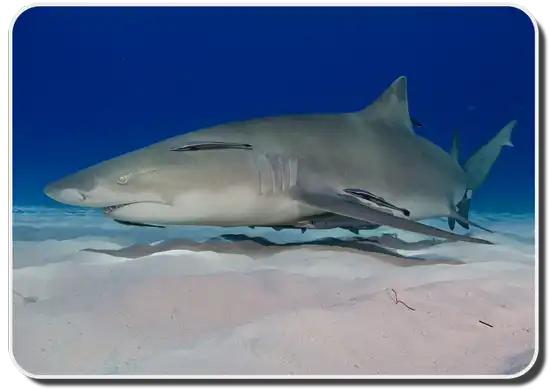
Shark anatomy is highly developed as a result of over 450 million years of evolution and has made sharks an incredibly successful species. Here is an overview of the unique anatomical characteristics that make sharks unique.
External Shark Anatomy
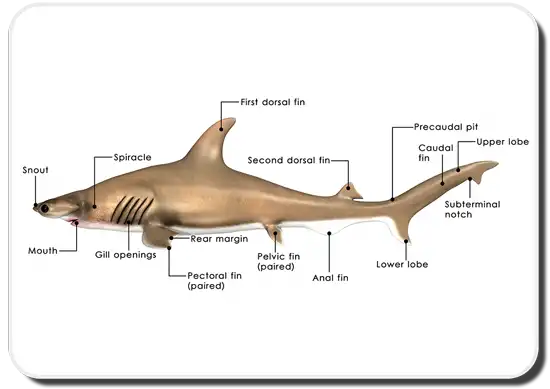
Shark Skin
Shark anatomy begins with the skin. If you’ve ever felt the rough, harsh texture of sandpaper, you can undoubtedly imagine how it would feel to caress the skin of a shark. Yes, sharks are known for the menacing teeth in their mouths, but many do not even realize that their skin is made up of dermal denticles; these are miniscule placoid scales that are similar to teeth. These dermal denticles are even covered in enamel, called vitro-dentine, and they also include dentine and a pulp cavity; they are extremely comparable with teeth.
Unfortunately, people kill sharks for their unique skin to make shagreen, a type of sandpaper, and various leather products. So when you think about it, if you have felt sandpaper, it is very possible that you have touched what was once part of a shark.
 Vortices and whirlpools are often formed behind the placoid scales as a shark swims. This helps the sharks swim efficiently. The fact that sharks are completely covered in tooth-like structures may seem alarming, but not only are they resourceful when it comes to swimming, but they also form a barrier of protection. Interestingly enough, however, while the dermal denticles are arranged in a pattern on the shark, they do not grow as the shark grows. Instead, the shark just sprouts more placoid scales as necessary. Therefore, age estimation cannot be determined by the scales of the shark, although, the ages of other fish can be calculated this way.
Vortices and whirlpools are often formed behind the placoid scales as a shark swims. This helps the sharks swim efficiently. The fact that sharks are completely covered in tooth-like structures may seem alarming, but not only are they resourceful when it comes to swimming, but they also form a barrier of protection. Interestingly enough, however, while the dermal denticles are arranged in a pattern on the shark, they do not grow as the shark grows. Instead, the shark just sprouts more placoid scales as necessary. Therefore, age estimation cannot be determined by the scales of the shark, although, the ages of other fish can be calculated this way.
Shark Fins
Here’s one of the more well known areas of shark anatomy. The fins of a shark are easily recognizable, and immensely important. Most sharks have five different types of fins, while some sharks only have four. These types of fins include:
- Pectoral
- Pelvic
- Dorsal
- Anal
- Caudal

At the front of the shark (anterior) behind its head, are the pectoral fins. Sharks use these fins to lift and steer them while they swim.

Behind the pectoral fins, are the pelvic fins; these keep the shark stabilized while it swims. In male sharks, pelvic fins are also used as claspers, which are necessary for the reproduction process.
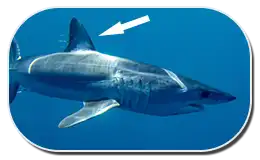
Dorsal fins are the ones that most people are familiar with; these fins are often seen when a shark is at the water’s surface. Oftentimes, sharks have a first and second dorsal fin. These fins are also used for stability during swimming.
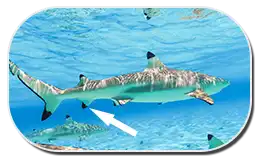
For some sharks, these fins are not enough to completely stabilize them. Therefore, the anal fin is present to provide additional stability to the sharks that possess them. The anal fin is located between the pelvic and caudal fins on the bottom, or ventral, part of the shark.

When it comes to the shark having the ability to propel itself through the water, they utilize what is called the caudal fin. This fin, also known as the tail fin, has an upper and lower lobe that, depending on the type of shark, can vary in shape and size. The upper lobe of the caudal fin produces the majority of the shark’s thrusting abilities. The tail fin is one of the most important parts of the entire shark anatomy.
Types Of Shark Tail Fins
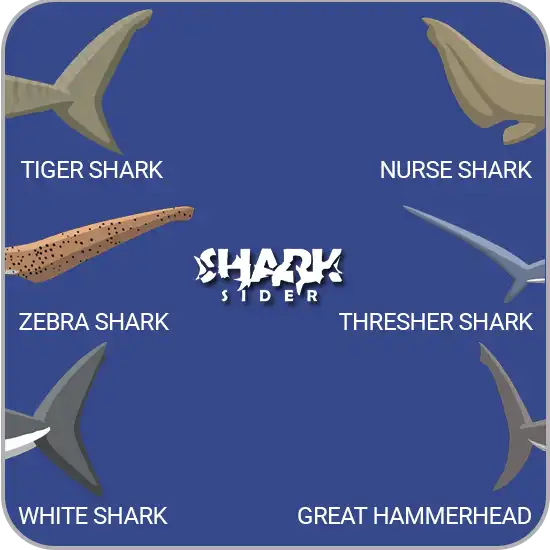
Because of all of these different types of fins, sharks are able to maneuver swiftly through the water while also remaining stabilized. Sharks are some of the strongest and most efficient swimmers in the entire ocean!
Spines
Spines are included in the shark anatomy as a form of protection. For many sharks and most rays, spines are included in their anatomy to defend them against potential predators. Although many associate sharks and rays as venomous, antagonistic bullies, defense mechanisms such as spines are used precisely for that, defense. Spines are not used aggressively. Many sharks have spines on their dorsal fins.
Gills
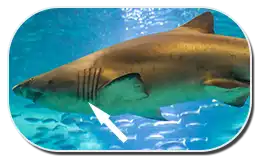
Like other fish, the shark anatomy includes gills to aid in respiration. Located on the side of a shark’s head are five to seven gill slits; in order for gas exchange to occur correctly, water has to consistently flow over the gill slits. Once the shark allows water to enter their mouth, it goes through the pharynx, over the gills, and finally leaves through the actual gill slits.
Aerodynamic Bodies
Sharks have a range of different body types, depending on the species. However all sharks have arrow dynamic bodies. They all have round bodies that taper at both the front and the back. This makes them extremely aerodynamic, so they can move through the water quickly without expending extra energy.
Shark Spiracle
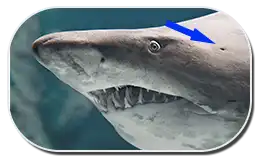
In some sharks, Spiracles are present as first gill slits. These slits are located behind the eyes, and they are used to send blood through a separate, unique blood vessel immediately to the eyes and brain of the shark. Although this feature of a shark’s anatomy sounds very useful, they are not present on many sharks. Spiracles are mainly found on sharks that typically dwell near the seabed, otherwise known as sedentary sharks. The faster swimming sharks usually do not posses this feature, and if they do happen to have Spiracles, they are most likely small in size.
Body Shape and Coloration
You many have noticed that the bodies of sharks are typically rounded and tapered at both ends. This type of shape causes them to have what is called a fusiform body. This body shape is exceedingly helpful because it minimizes drag, and it enables sharks to swim efficiently while using the least amount of energy possible.
The coloration of sharks is enormously unique and important; not only is it yet another form of protection from their predators, but it also aids them when capturing prey. The dorsal (top) side of a shark is a lighter color than the ventral (bottom) side. This coloration is a type of camouflage called counter shading. When viewed from above, the dark side of the shark blends in with the depths of the ocean. When viewed from below, the light ventral side blends in with the ocean’s surface. This enables sharks to slip past predators, and sneak-up on prey. Talk about convenience!
Internal Shark Anatomy
Body Cavity
If you were to look inside the body of a shark, you would notice many of the same organs that humans have. Both sharks and humans have stomachs (although human trash can often be found in a shark’s stomach) spleens, pancreas, rectums, and liver.
There is a huge difference between the human liver and the shark liver however. The liver is usually the first thing one would notice when peering inside and seeing the shark anatomy. A shark’s liver can take up approximately 25% of the total body weight. The liver is detrimental to the shark, and it has two purposes. Fatty reserves are kept in the liver, thus causing it to be a store of energy. In addition, the liver actually keeps the shark from sinking. Buoyancy is what works against the tendency of sinking; because the liver stores oils that are lighter than water, the density of the shark’s body is lighter, thus supplying the needed buoyancy for the shark. Due to this particular function, the liver is considered to be a hydrostatic organ.
Shark Digestion
The shark anatomy includes an intestine that is used for digestion. The shark’s intestine is shortened, but it also spirals so that it takes up the least amount of space possible. When a shark needs to get rid of waste, it utilizes its kidneys, genitals, and cloaca. The cloaca is an opening that the kidneys and genitals empty into.
Shark Skeleton
The skeleton of a shark is entirely composed up of cartilage. It is a bit alarming, but sharks do not have bones. The fact that sharks have cartilage instead of bone is extremely beneficial. Cartilage is lighter than bone; this helps the shark stay afloat. Because cartilage is also extensively durable and flexible, sharks have the ability to have tight radius turns. The skull of a shark, which is also comprised of cartilage, can vary in shape. In fact, there are numerous ways in which a shark’s jaw can be connected to the cranium; the method in which the shark feeds, determines how the jaw will attach to the cranium.
Mouth, Teeth, And Sense Of Taste
The mouth of a shark, one of its most recognizable features, is usually located on the ventral side. The inside of a shark’s mouth is full of rows and rows of teeth. Like a shark’s skin, massive placoid scales make up the teeth of a shark. Because sharks don’t have a literal jawbone for the teeth to attach themselves to, they are connected to the skin that covers the jaw cartilage. Sharks are constantly replacing their teeth; believe it or not, some sharks use more than 30,000 teeth over a life span. When a new tooth grows, the skin maneuvers the tooth into a proper position.
Although an extensive amount of information has not been found about sharks, we do know that they have taste buds. Some sharks spit things out after they have bit into them; this is most likely due to the fact that they did not like the particular taste. Sharks have the reputation of devouring almost anything and anyone, but they are certainly pickier than many people realize.
Ampullae of Lorenzini, Lateral Line, And Sense Of Sound
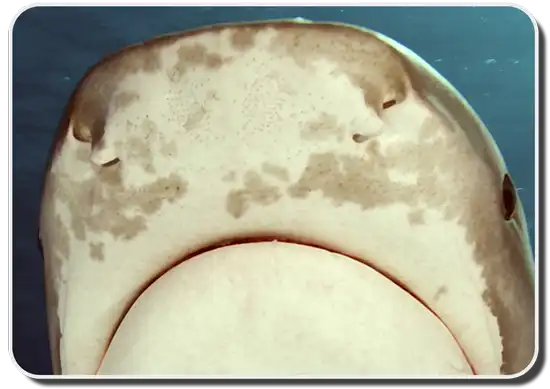
Because sharks use the sense sound to find their food, ears are needed in addition to the ampullae of Lorenzini and the lateral line. Sharks have an inner ear that is used to pick up acceleration and gravity in addition to sound.
Eyes, Eyelids, and Eyesight
Sharks have exceptional eyes that enable them to see acutely, even in low light. Behind their retina, is the tapetum lucidum; this is a layer that is comprised of silver guanine crystals that reflects light as it exits the eye. This is the part of the shark anatomy that enables sharks to have the ability to see in low light.
The eyelids of some sharks are certainly not typical. There are sharks that have what is called a nictating membrane. This feature provides a substantial amount of protection for the eye. When sharks get relatively close to a particular object, or when they are feeding, the nictating membrane closes, thus acting as a shield for the eye. Some sharks, like the Great White shark, actually have a set of muscles that roll the eye into its socket whenever the eye needs protection.
The eyesight of bony fish pales in comparison to the sight of a shark. The shark anatomy allows them to see in dim light, they can detect the contrasts of light and shadow, and their pupils can dilate and contract.
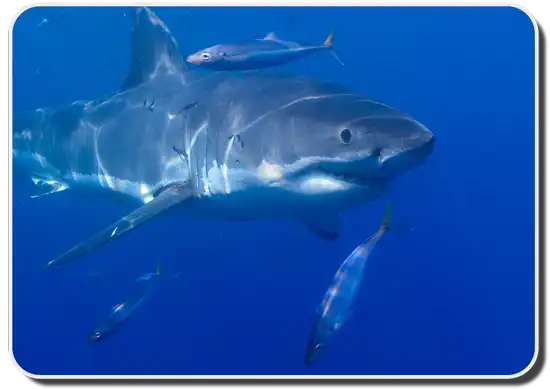
Powerful Muscles
Sharks have two types of extremely powerful muscles. The first type, red muscle, is found under their skin and works to break down the fats and oils in the body to produce energy. Red muscle provides a steady stream of energy and helps sharks continuously cruise through the water. The second types of muscle is white muscle which breaks down sugars to produce energy. White muscle is used when the shark is either attacking or dodging predators, because it gives them an extra burst of quick energy and movement. Having two sets of muscles reduces the energy needs of a shark, making them more efficient, stronger swimmers.
All of these unique anatomical characteristics make sharks an amazing species. Between the efficiency of cartilaginous bones, oily liver, and aerodynamic bodies using two sets of muscles, and the incredible defense of denticles, regenerative teeth, and countershading, it’s no wonder sharks have outlived even the dinosaurs.
Nostrils And Sense Of Smell
The nostrils of a shark are and external part of the shark anatomy, and on the ventral side of their bodies. Some species of sharks have barbells, otherwise known as whiskers, near their nostrils. A shark’s sense of smell is unbelievably keen. For example, they can detect a drop of blood hundreds of feet away. Certain chemicals with a concentration as low as one part per billion, can be detected by the nostrils of a shark.
I could go on forever, but hopefully you learned a few cool things about the shark anatomy. Keep browsing this site for even more info about sharks!
